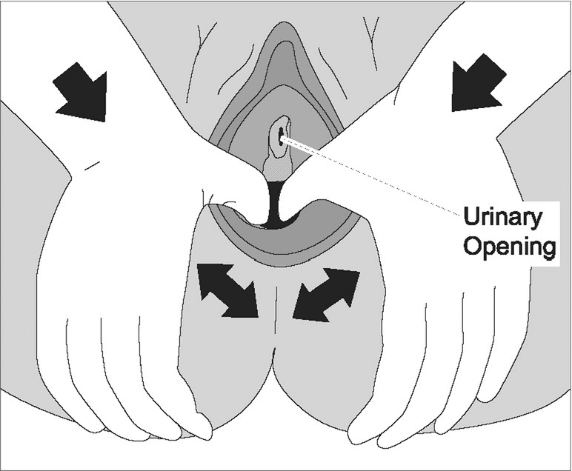What is My “Perineum”?
Your perineum is the area between your vaginal opening and your rectum. This area stretches a lot during childbirth, and sometimes it tears. If your health care provider cuts an episiotomy during birth, it is this area that is cut. You may need stitches after your baby is born if you have a tear or have an episiotomy.
I’m Concerned About Perineal Tears – How Often Do They Occur?
40% to 85% of all women who give birth vaginally will tear. About two-thirds of these women will need stitches.
I’m Also Concerned About Episiotomies – Are They Necessary?
An episiotomy is not necessary for most women. Although they were common before the 1990s, they are rarely done today. However, sometimes your health care provider may recommend an episiotomy just as your baby is being born. For example, an episiotomy can help if your baby needs to be born very quickly. You can ask your health care provider to talk with you about episiotomy during a prenatal visit
Can My Health Care Provider Do Anything to Help Me Avoid a Tear?
There are many ways that your health care provider can help to reduce your chance of tearing. For example, your provider may:
- Apply a warm compress to the perineum just before the baby comes out
- Recommend specific positions for you to be in as you push
- Provide gentle downward pressure on the baby’s head as your baby is coming out
- Ask that you push your baby out between contractions
- Avoid the use of forceps or a vacuum to help your baby be born
Can I Do Anything Before The Birth To Help Me Avoid a Tear?
Preventing a perineal tear that occurs during birth has been the subject of many research studies. Several studies have found that perineal massage during the last weeks of pregnancy can reduce tearing at birth for women giving birth for the first time. This massage – using 2 fingers to stretch your perineal tissues—is performed by you, in your home, once or twice a week, for the last 4 to 6 weeks of your pregnancy. For every 15 women who do perineal massage, one woman will avoid an episiotomy and perineal tearing that needs stitches. While you massage, you can practice relaxing the muscles in your perineum. This can help you prepare for the stretching, burning feeling you may have when your baby’s head is born. Relaxing this area during birth can help prevent tearing.
Does Perineal Massage in Pregnancy Help All Women?
Massage seems to work better for some women than others. Women having their first baby, women 30 years or older, and women who have had episiotomies before have fewer tears and less severe tears when perineal massage is done during the last weeks of pregnancy.
Can My Partner Help?
Yes! Many women find that it is easier to have their partners do this massage.
Are There Any Risks to Perineal Massage During Pregnancy?
Not that we know of. It is free. It doesn’t hurt. It is easy to do. And most women don’t mind doing it. However, you should check with your health care provider before beginning perineal massage. And, if you believe your bag of waters is leaking, check with your health care provider before putting anything in your vagina.
Instructions for Perineal Massage During Pregnancy
- Wash your hands well, and make sure your fingernails are short. Relax in a private place where you can rest with your legs open and your knees bent. Some women like to lean on pillows for back support.
- Lubricate your thumbs and the perineal tissues. Use a lubricant such as vitamin E oil, coconut oil, almond oil, or any vegetable oil used for cooking – like olive oil. You may also try a water‐soluble jelly, such as K‐Y jelly, or your body’s natural vaginal lubricant. Do not use baby oil, mineral oil, or petroleum jelly (Vaseline).
- Place your thumbs about 1 to 1.5 inches inside your vagina. Press down (toward the anus) and to the sides until you feel a slight burning, stretching sensation.
- Hold that stretched position for 1 or 2 minutes.
- With your thumbs, slowly massage the lower half of the vagina using a U‐shaped movement for 2 to 3 minutes at most. Concentrate on relaxing your muscles. This is a good time to practice slow, deep breathing techniques.
- Partners: If your partner is doing the perineal massage, follow the same basic instructions above. However, your partner should use his or her index fingers to do the massage (instead of thumbs). The same side‐to‐side, U‐shaped, downward pressure method should be used. Good communication is important – be sure to tell your partner if you have too much pain or burning!



















